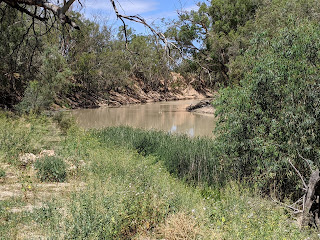On the last full exploring western NSW, we left Pooncarie and headed to Mungo National Park. On our way there we saw at the roadside a remarkable display of trash probably discarded by a local farm property. I've not anything like it before. Let's have a look:

This sign at the side of the road caught our eyes and it accurately describes the display. Whenever bras boots and pianos are discarded they are displayed artistically at the kerbside!
Here, for example, is a tree smothered in discarded foot-ware.
The pianos were a bit hard to miss! Have you ever seen two pink-coloured pianos setting at the road-side?
And the bras decorate this tree nicely.
So when you want toss things out in future you might consider, say, nailing your underwear to a tree on your property or displaying a discarded shirt on something that looks like a scarecrow. I guess, however, that the region's hot dry weather might prevent used clothing from wasting away.
A little further on we came to a sign introducing us to the National Park. You've probably never heard of it, but it is world famous because it was here that archaeologists discovered the remains of Mungo man whose skeleton was dated back some 42,000 years. At his death he was probably aged about 50 and 1.7 m tall, perhaps a little lower than the average today.
After another quick tour of the visitor's centre, we joined a group of people booked on a tour of the park.
After the visitor's centre, we all saw the interior of a wool shed created in the 19th century by a local farm. It was here that sheep would be shorn of their wool annually. It would then be transported on a barge down the Darling River towards local and overseas markets
Our party took a bus out across Lake Mungo, which had little if any water. We headed to the walls of China whose name was given by Chinese migrants to the area. Shown her in the distance, it is an accumulation of wind-blown sand, which over the centuries, has steadily moved eastwards - a process going on today. Going east, it has been blown up a ridge some 40 + km in length. It's a long wall, but nowhere the length of the Chinese version!
Getting closer, we can the whitish sand rising in front of us. People wishing to visit and climb the wall have to be in a tour party. People can drive their cars to a fence and loom the sand, but tours parties are under supervision of a guide who can prevent damage to the site.
Here we are slowly walking towards the ridge.
I think that's Dot at the back. Notice that the sand in front is white, while beyond that the sand turns darker.
Here we are now on the darker bit and, as you can see, the surface is becoming rockier.
However, there is a slight amount of vegetation also.
On the way up I noticed what looks like a skeleton in a rock face ...but not Mungo man. Maybe it's a relative of the crocodile!
Now we're getting into really rocky terrain as this and the following picture show
Again, there's a minimal vegetation including small trees and shrubs.
Now our party has reached the top of the 'wall' and looks out westwards across the lake bad which is green from all the small shrubs that cover it.
As you can see from the two picture below, the sand and rock can create some impressive ladnscapes.
After returning to the bus, we were driven back to the Lake Mungo lodge where we met up with and hand fed some voracious Emus like the one's shown here. They seem to like visitors, which is unsurprising since they got a good feed. After going back to the visitor information centre, we returned to Rebecca's car and drove off for a long circular tour behind the wall - i.e. to the east of it.
Travelling southwards down the western side of the wall, the countryside was again sandy with sparse vegetation.
The sand became hillier as we skirted the southern edge of the 'wall'
And, as we crossed to the eastern side we were met by another dead flat plain. At least it was a lovely green colour with all the brasses and shrubs adorning it.
We even found something called a "lake" containing a small amount of water
The figure you see is Rebecca.
I also liked the wispy cloud-scape that you can see.
Travelling northwards we slowly encroached back on to the sand.
This would have been maybe 30 km north of where we rounded the southern end of the 'wall'.
As we rounded the top end of the wall, we saw a path leading to the top of the dune and both Rebecca and I decided to join various parties of people heading to the top.
Here I am resting on a sign advertising the supposed 'lake' as we headed back to the tourist centre.
All up it was a lovely journey. We then headed down a long dirt road to Balranald just north of the Victorian border.
We stayed the night this pretty little town and, in the morning went down to another of the great river systems making up the Murray - Darling Basin.
This is the Murrumbidgie, which has its source not far from Canberra, which is about an 8 hour drive away.
Again, here's Rebecca admiring the scenery.
The rover itself was, like the Darling we saw earlier, flowing only very slowly and with what looked like a low water volume.
And here is the last photo posted on our roughly 10 day journey.
AS























































